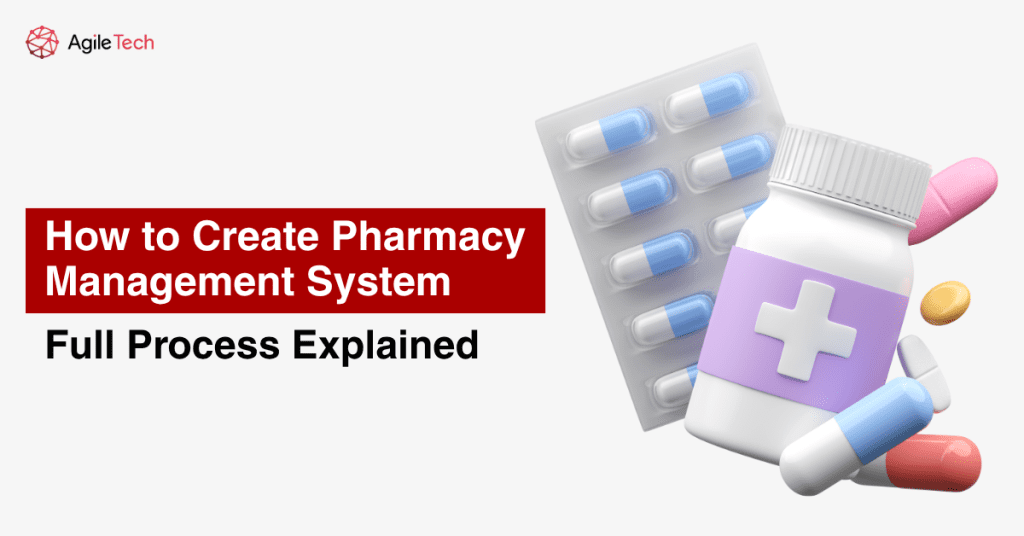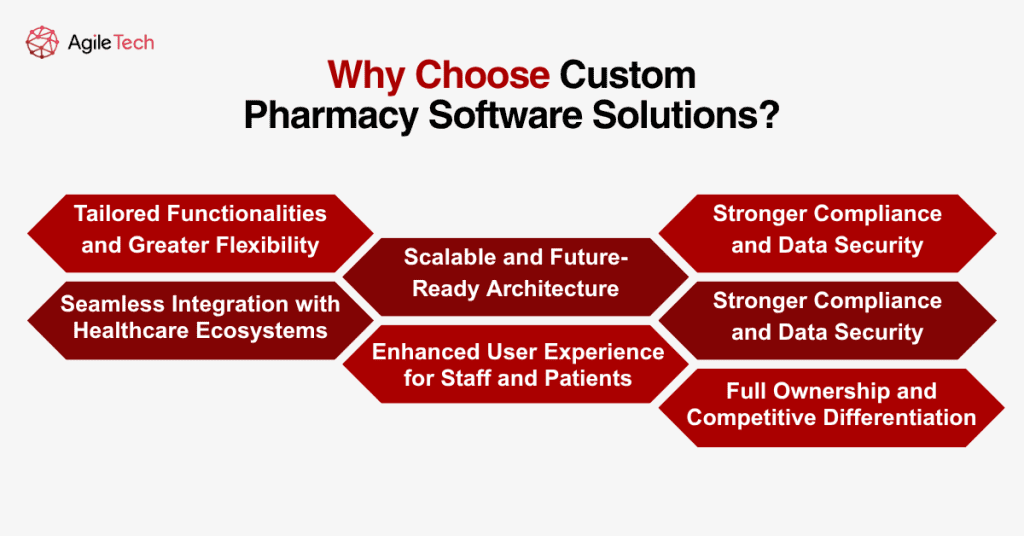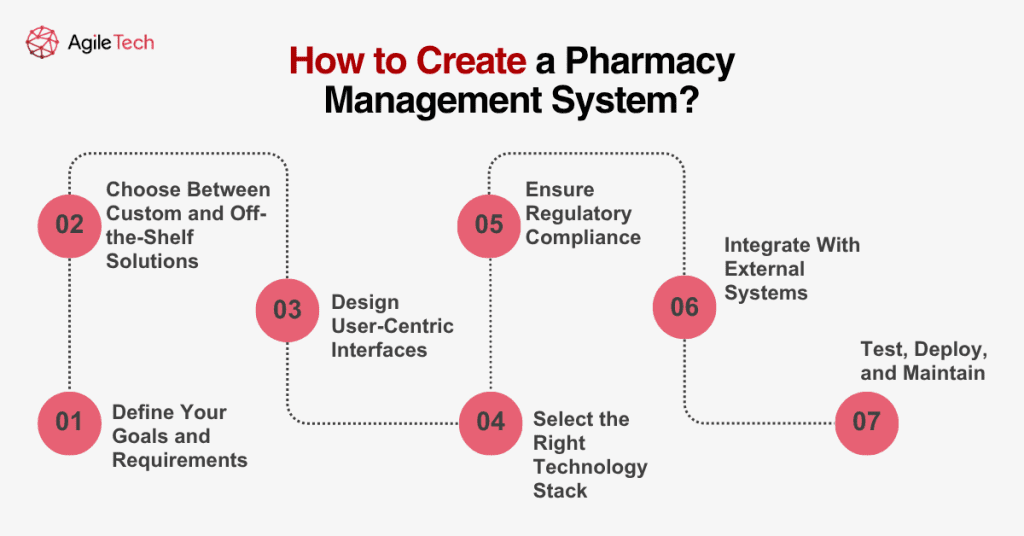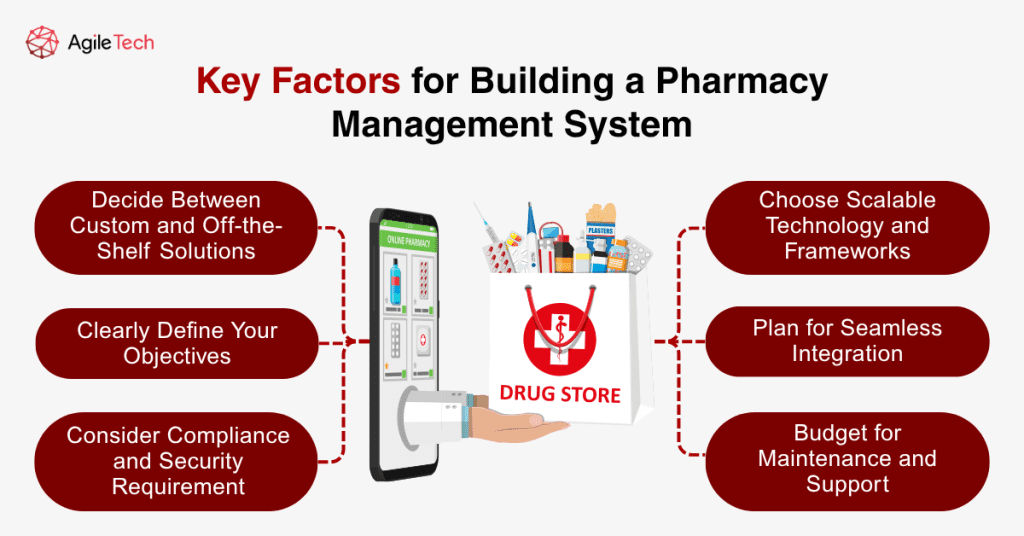How to Create Pharmacy Management System: Full Process Explained
In today’s fast-paced pharmaceutical industry, a powerful pharmacy management system is essential to streamline operations, reduce errors, and improve customer service. While traditional pharmacy computer software systems offer basic tools, many businesses now turn to custom pharmacy software solutions for greater flexibility and scalability.
This blog explores the key features of a pharmacy management system, the process of pharmacy management software development, and how to build a modern, efficient pharmacy software system using the right technologies and frameworks for pharmacy software.

- 1. Why Choose Custom Pharmacy Software Solutions?
- 2. What Features to Implement into Pharmacy Management Software?
- 3. How to Create a Pharmacy Management System?
- 4. Key Factors to Keep in Mind Before Building a Pharmacy Management System
- 5. How AgileTech Builds Scalable Pharmacy SoSystems
- 5. Conclusion
- FAQs
1. Why Choose Custom Pharmacy Software Solutions?
A pharmacy management system is a digital solution designed to help pharmacies automate and optimize their daily operations. From managing prescriptions and inventory to handling billing and patient records, a well-developed pharmacy software system plays a critical role in improving accuracy, speed, and compliance. As digital demands in healthcare grow, many pharmacies are looking beyond traditional pharmacy computer software systems and exploring more tailored options.
Choosing custom pharmacy software solutions allows businesses to build a system that fits their unique workflows, regulatory requirements, and future growth plans. Unlike off-the-shelf platforms, custom development gives you full control over the features of a pharmacy management system and the technology stack used. Here are a few reasons why this approach is increasingly preferred:

Tailored Functionalities and Greater Flexibility
Generic pharmacy tools may not accommodate unique workflows, multi-location operations, or specialized reporting requirements. With pharmacy management software development tailored to your needs, you can build functionality from the ground up, whether it’s automated refill notifications, detailed medication interaction alerts, or barcode-based inventory management.
Seamless Integration with Healthcare Ecosystems
Your pharmacy system doesn’t operate in isolation. It must integrate with EHR platforms, insurance verification services, supplier APIs, and more. Custom development enables tight integration across your tech stack, leading to faster workflows, better data accuracy, and improved care coordination.
Scalable and Future-Ready Architecture
Using the right framework for software pharmacy platforms depend on such as microservices, modular designs, and cloud infrastructure, ensures your solution can scale with your business. As regulations change or customer demand grows, your platform can evolve without needing to be rebuilt from scratch.
Enhanced User Experience for Staff and Patients
Custom software gives you full control over the system’s interface. You can optimize usability for pharmacists, assistants, and front-desk staff while also introducing patient-facing features like online prescription tracking or notifications, all designed around real user behaviors.
Stronger Compliance and Data Security
Pharmacy systems handle sensitive patient data, making security and compliance essential. Custom software allows you to implement security protocols aligned with HIPAA, GDPR, or national healthcare laws from day one, protecting both patients and your business from legal risks.
Faster Response to Market and Regulatory Changes
With custom-built solutions, you’re not limited by vendor update cycles. You can respond quickly to changes in local drug policies, pricing regulations, or digital health mandates, keeping your pharmacy ahead of the curve.
Full Ownership and Competitive Differentiation
Custom pharmacy management software development gives you full ownership over the source code and roadmap. That means no recurring licensing fees, no vendor lock-in, and the freedom to innovate. You can introduce features that differentiate your brand, whether through AI-driven insights, tailored dashboards, or smart refill systems that off-the-shelf platforms simply don’t support.
By investing in custom pharmacy software solutions, you gain more than just a tool, you gain a competitive advantage. The right solution not only supports your pharmacy today but also scales and adapts as regulations, technology, and customer expectations evolve.
2. What Features to Implement into Pharmacy Management Software?
An effective pharmacy management system should go beyond basic prescription processing. To truly support pharmacy operations, whether for independent stores or multi-location chains, it needs to combine automation, compliance, inventory accuracy, and customer-centric tools. The right set of features not only streamlines day-to-day tasks but also supports scalability, improves service quality, and ensures regulatory compliance. Here are the essential features of a pharmacy management system you should implement during pharmacy management software development:
Prescription Management
This is the backbone of any pharmacy platform. It allows pharmacists to receive, validate, and dispense prescriptions digitally, reducing human error and improving processing speed. Advanced systems can auto-check for drug interactions, suggest generics, and comply with e-prescription standards.
Inventory & Stock Control
With thousands of SKUs and expiration-sensitive products, real-time inventory management is a must. A good pharmacy software system tracks stock levels, batch numbers, expiration dates, and reorder thresholds. Integration with suppliers or wholesalers allows automated reordering to avoid shortages or overstocking.
Point-of-Sale (POS) Integration
Efficient sales management is critical at the front desk. An integrated POS supports barcode scanning, real-time inventory sync, multiple payment gateways, loyalty points, and automatic tax calculations. For insurance-covered purchases, it also facilitates claims processing.
Patient & Customer Profiles
Storing comprehensive customer data: medical history, previous purchases, allergies, and contact info enables personalized service, faster checkout, and proactive patient engagement. Some systems also allow customers to view their prescriptions, order refills, or get reminders via a mobile app or SMS.
Reporting & Analytics
Insightful dashboards and custom reports help business owners understand sales performance, drug turnover rates, staff productivity, and operational bottlenecks. These data-driven insights are essential for long-term decision-making and business optimization.
Security & Role-Based Access
Given the sensitive nature of health data, modern systems enforce strict access control. Permissions can be assigned based on roles (e.g., cashier, pharmacist, admin), and audit trails help track all activity for compliance and accountability.
Alerts & Automated Notifications
Automated alerts improve operational efficiency, whether it’s low stock, expiring meds, overdue prescriptions, or refill reminders. Notifications sent to patients can also boost engagement, loyalty, and medication adherence.
Integration with EHRs, Insurance & APIs
To deliver seamless care, pharmacies must connect with external systems like hospitals, clinics, or insurers. Through EHR and API integration, pharmacists can receive direct prescriptions, verify patient data, and streamline reimbursement processes.
Multi-Branch Support & Cloud Accessibility
For pharmacy chains or growing businesses, cloud-enabled architecture allows centralized control, real-time updates across locations, and remote access. This ensures consistency, standardization, and simplified business scaling.
Compliance with Regulations
Custom pharmacy management software development should include features that ensure full compliance with local and global health data laws, such as HIPAA, GDPR, or national drug control authorities.
Support for Custom Workflows
One of the biggest benefits of custom pharmacy software solutions is the ability to design workflows that reflect how your team actually works, not how generic software assumes they do. This could include customized dashboards, role-specific interfaces, and location-based rules.
Modular, Scalable Architecture
To future-proof your investment, modern systems should be built using flexible frameworks that software pharmacy platforms can evolve on. This allows you to start with core modules, then add features like mobile apps, telepharmacy tools, or business intelligence dashboards as your needs grow.
By prioritizing these features in your pharmacy management software development, you ensure that your system is not only functional but future-ready, capable of improving workflows, reducing manual tasks, and delivering a better experience for both pharmacists and patients. Whether you’re planning a new platform or upgrading an existing one, choosing the right functionality is a key step toward building scalable, modern pharmacy software systems.
3. How to Create a Pharmacy Management System?
Building a robust and scalable pharmacy management system involves more than just writing code, it’s about solving real operational challenges with technology. From prescription tracking and stock control to billing and regulatory compliance, an effective solution must be carefully planned, designed, and developed to suit the unique needs of each pharmacy.
Here’s a complete look at the pharmacy management software development process and the key steps to consider:

3.1. Define Your Goals and Requirements
Start by identifying what problems the system needs to solve. Are you aiming to reduce prescription errors, improve inventory control, or integrate with external platforms like EHRs or insurance systems? Clarify your business goals, expected workflows, compliance needs, and whether you’re building for a single store or multiple branches. This foundation ensures the end product aligns with your pharmacy’s operational model.
3.2. Choose Between Custom and Off-the-Shelf Solutions
Choosing the right development approach is a foundational step in pharmacy management software development. While off-the-shelf pharmacy computer software systems are appealing for their quick deployment and lower upfront costs, they often fall short in meeting the unique operational requirements of modern pharmacies. These platforms typically come with fixed modules, limited customization, and vendor-lock constraints that hinder long-term scalability.
In contrast, custom pharmacy software solutions allow businesses to build a pharmacy software system tailored to their exact needs. Pharmacies can decide which features to include, how to structure workflows, and which third-party APIs to integrate, from insurance systems to supplier platforms. This flexibility is especially valuable in multi-location chains, niche pharmacy operations, or regions with strict regulatory demands
3.3. Design User-Centric Interfaces
A smooth and intuitive user experience is key. The system should be easy to use for pharmacists, assistants, and front-desk staff, with dashboards tailored to each role. A good pharmacy software system design considers layout, accessibility, and responsiveness across devices.
Key benefits of user-centric interface design include:
- Streamlined workflows and faster task completion
- Reduced training time for new staff
- Fewer input errors and improved accuracy
- Higher staff satisfaction and system engagement
- Better service delivery to patients
3.4. Select the Right Technology Stack
Choosing the right frameworks for software pharmacy systems depends on balancing performance, security, and scalability. Technologies like React or Angular (for front-end), Node.js, Python, or Java (for backend), and cloud infrastructure like AWS or Azure are commonly used. Databases must be secure and support real-time transactions.
3.5. Develop Core Features
Once the planning, UI/UX design, and system architecture are finalized, it’s time to begin development of the essential modules that form the foundation of your pharmacy management software system. These core features are critical to daily operations and ensure your platform delivers real business value from day one. Here’s a breakdown of the must-have modules:
- Prescription processing
- Inventory and batch tracking
- POS and billing
- User management and role-based access
- Reporting and analytics
- Alerts and notifications
- Compliance and audit logging
To successfully implement these modules, you’ll need a skilled cross-functional team, including software developers, UI/UX designers, QA testers, and pharmacy domain consultants. Their collaboration ensures the system is not only technically sound but also aligned with pharmacy workflows and healthcare industry standards.
3.6. Ensure Regulatory Compliance
In the healthcare domain, ensuring compliance with national and international regulations is non-negotiable. A pharmacy management system must be built to meet strict legal and ethical standards for data privacy, security, and operational transparency. Depending on your region, these may include:
- HIPAA (Health Insurance Portability and Accountability Act) in the U.S.,
- GDPR (General Data Protection Regulation) for the European Union,
- MOH or national health standards for other countries in Asia, LATAM, or the Middle East.
3.7. Integrate With External Systems
Modern pharmacies no longer operate in isolation; they’re an integrated part of the broader healthcare and logistics ecosystem. That’s why custom pharmacy software solutions must support seamless integration with a wide range of third-party platforms through secure healthcare integration APIs.
Key integrations may include:
- Electronic Health Records (EHR/EMR): Connecting your pharmacy system with EHR platforms improves care coordination by allowing real-time access to patient medication history, allergies, and physician instructions.
- Insurance and Payment Gateways: Automating insurance eligibility checks, claim submissions, and co-payment calculations improves billing speed and reduces manual errors.
- Supplier APIs: Integration with suppliers and wholesalers ensures real-time inventory updates, streamlined reordering processes, and better tracking of drug batches and expiry dates.
3.8. Test, Deploy, and Maintain
Before launch, the software should be thoroughly tested for bugs, security issues, and performance bottlenecks. Once deployed, ongoing maintenance is crucial for applying security patches, releasing new features, and adapting to business growth.
Creating a fully functional pharmacy management system is a strategic investment that can redefine how your pharmacy operates. Whether you’re planning to build a solution from scratch or upgrade an existing system, partnering with an experienced pharmacy management software development company can help bring your vision to life securely, efficiently, and at scale.
4. Key Factors to Keep in Mind Before Building a Pharmacy Management System
Developing a high-performing pharmacy management system is a strategic investment that requires careful planning and clear direction. Whether you’re running a single pharmacy or managing a chain, it’s important to build a solution that addresses current pain points, aligns with long-term goals, and complies with healthcare regulations. Jumping into development without considering these core elements often leads to rework, overspending, or worse, systems that don’t meet real-world needs.
To ensure the success of your pharmacy management software development project, here are several key factors to consider:

4.1. Clearly Define Your Objectives
Start with a clear understanding of why you’re building or upgrading your pharmacy software system. Are you aiming to automate inventory tracking, eliminate prescription errors, integrate with EHR systems, or enhance patient engagement? By defining business outcomes early, you can ensure the final solution aligns with your operational goals and delivers measurable value.
4.2. Decide Between Custom and Off-the-Shelf Solutions
Off-the-shelf pharmacy computer software systems might be tempting due to their fast deployment and lower upfront cost. However, they often lack the flexibility and scalability needed for complex operations. On the other hand, custom pharmacy software solutions offer tailored workflows, deeper integrations, and full control over features and UI/UX, making them ideal for pharmacies with unique processes or plans for expansion.
4.3. Consider Compliance and Security Requirements
Healthcare and pharmaceutical data are highly sensitive, so your system must meet strict security standards. Depending on your location, this may include HIPAA, GDPR, or local Ministry of Health regulations. Addressing these requirements early in the pharmacy management software development process helps avoid legal issues and ensures long-term system trustworthiness.
4.4. Plan for Seamless Integration
A modern pharmacy software system doesn’t operate in a vacuum. It should integrate smoothly with EHR platforms, billing systems, supplier APIs, insurance networks, and government portals. Ensuring interoperability reduces manual input, improves accuracy, and enhances efficiency across your entire ecosystem.
4.5. Choose Scalable Technology and Frameworks
The success of your solution also depends on the framework software pharmacy platforms are built. Opt for a modular architecture and scalable technologies that allow you to add features over time, expand to multiple locations, and support cloud access or mobile applications. This flexibility is key for staying competitive in an evolving market.
4.6. Budget for Maintenance and Support
Don’t just budget for development, plan for long-term support and system upgrades. Software must evolve with changes in regulations, technology, and customer expectations. Working with a reliable pharmacy management software development partner ensures you’re not left behind as the industry advances.
Taking time to evaluate these critical factors before development begins can help you avoid costly missteps and create a system that truly empowers your pharmacy operations. Whether you’re starting from scratch or reengineering an outdated platform, thoughtful planning is what turns a pharmacy system into a long-term business asset.
5. How AgileTech Builds Scalable Pharmacy SoSystems
At AgileTech, we specialize in building high-performance, tailor-made pharmacy software systems that meet the evolving needs of modern pharmacies, from independent retailers to large healthcare networks. With years of experience in pharmacy management software development, we combine deep technical expertise with healthcare industry insights to deliver solutions that are not only functional but also scalable and future-ready.
A Process Rooted in Flexibility and Precision
Our development approach begins with a deep dive into your business workflows, compliance needs, and technical environment. Instead of offering one-size-fits-all products, we focus on building custom pharmacy software solutions that fit seamlessly into your operations.
We carefully select the most suitable technologies and frameworks for pharmacy software, ensuring optimal performance, data security, and long-term maintainability. Whether you need an end-to-end pharmacy management system or want to upgrade legacy modules like inventory or POS, our team designs systems that are modular, cloud-enabled, and easy to scale.
Collaboration That Drives Long-Term Value
AgileTech works as an extension of your team, from idea validation and UX design to development, testing, and post-launch support. We follow Agile methodology, so you get transparency, flexibility, and continuous improvements throughout the project lifecycle.
By focusing on both the core features of a pharmacy management system and your pharmacy’s unique needs, we ensure the platform not only supports day-to-day tasks but also empowers you to adapt quickly to industry changes and business growth.
5. Conclusion
Developing a modern pharmacy management system is no longer a luxury—it’s a strategic move to stay competitive, improve operational efficiency, and deliver better patient experiences. From prescription automation and inventory tracking to billing and compliance, pharmacies need reliable, scalable platforms tailored to their specific needs.
This guide has walked you through how to create a pharmacy management system that fits both current requirements and future growth. By focusing on smart planning, feature-rich architecture, and secure integrations, businesses can build a robust pharmacy software system that simplifies daily workflows and supports digital transformation.
Whether you’re building from scratch or upgrading existing tools, investing in custom pharmacy software solutions and partnering with a trusted pharmacy management software development company will ensure your system is flexible, compliant, and built on solid technical foundations. With the right frameworks, software pharmacy systems depend on, your solution can grow alongside your pharmacy and adapt to changes in the healthcare landscape.
